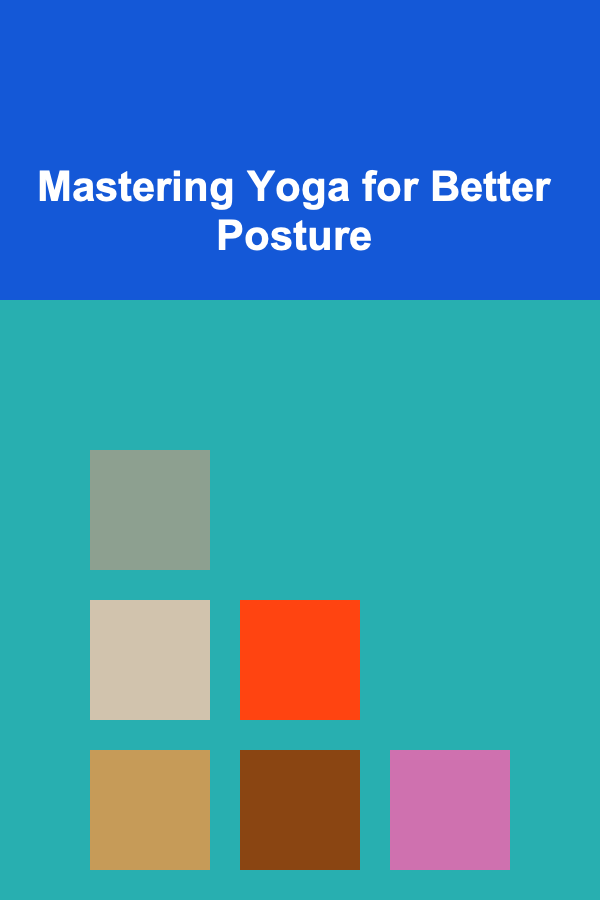
Mastering Yoga for Better Posture
ebook include PDF & Audio bundle (Micro Guide)
$12.99$7.99
Limited Time Offer! Order within the next:

In today's world, characterized by prolonged periods of sitting, staring at screens, and repetitive movements, poor posture has become an increasingly prevalent issue. The consequences extend beyond mere aesthetic concerns, impacting physical health, mental well-being, and overall quality of life. From chronic back pain and headaches to restricted breathing and reduced confidence, the negative effects of slouching and misalignment are far-reaching. Fortunately, yoga, an ancient practice that combines physical postures, breathwork, and mindfulness, offers a powerful and holistic approach to improving posture and reclaiming a more balanced and aligned body.
Understanding the Connection Between Posture and Well-being
Before delving into specific yoga techniques, it's crucial to understand the profound connection between posture and overall well-being. Posture isn't just about how you stand or sit; it's a reflection of the underlying structure and alignment of your entire body. When your body is properly aligned, your muscles can work efficiently, your joints are supported, and your internal organs function optimally. Conversely, poor posture places undue stress on certain muscles and joints, leading to pain, fatigue, and a cascade of other problems.
Consider the following:
- Muscle Imbalances: Poor posture often leads to muscle imbalances, where some muscles become shortened and tight while others become lengthened and weak. For example, prolonged sitting can lead to tight hip flexors and weak glutes, contributing to an anterior pelvic tilt and lower back pain.
- Joint Stress: Misalignment puts excessive pressure on joints, accelerating wear and tear and increasing the risk of arthritis and other joint problems. Slouching, for instance, compresses the vertebrae in the neck and upper back, leading to pain and stiffness.
- Respiratory Issues: Slumped posture restricts the diaphragm, the primary muscle of respiration, hindering its ability to expand fully. This can lead to shallow breathing, reduced oxygen intake, and decreased energy levels.
- Digestive Problems: Compressed abdominal organs can impair digestion, leading to bloating, constipation, and other digestive discomforts.
- Mental Health: Posture has a direct impact on mood and self-esteem. Studies have shown that adopting an upright posture can increase feelings of confidence and reduce stress and anxiety. Conversely, slouching can contribute to feelings of depression and low self-worth.
Yoga: A Holistic Approach to Posture Correction
Yoga's unique blend of physical postures (asanas), breathwork (pranayama), and mindfulness techniques makes it an ideal practice for addressing postural imbalances and promoting overall well-being. Unlike other forms of exercise that focus solely on strengthening or stretching individual muscles, yoga works to integrate the entire body, fostering awareness of alignment and promoting a more balanced and harmonious posture.
Here's how yoga helps improve posture:
- Strengthening Weak Muscles: Yoga asanas strengthen postural muscles that are often weakened by poor posture, such as the core, back extensors, and glutes.
- Stretching Tight Muscles: Yoga asanas release tension in tight muscles that contribute to postural imbalances, such as the chest, shoulders, and hip flexors.
- Improving Body Awareness: Yoga cultivates body awareness (proprioception), helping you become more aware of your posture throughout the day and enabling you to make conscious adjustments.
- Enhancing Core Stability: A strong core is essential for maintaining good posture. Yoga asanas strengthen the core muscles, providing a stable foundation for the spine and supporting proper alignment.
- Promoting Spinal Alignment: Many yoga asanas are designed to promote spinal alignment, helping to restore the natural curves of the spine and alleviate pressure on the vertebrae.
- Reducing Stress and Tension: Stress and tension can contribute to poor posture by causing muscles to tighten and shorten. Yoga's relaxation techniques help to release tension and promote a more relaxed and open posture.
Key Yoga Poses for Posture Improvement
While a comprehensive yoga practice offers numerous benefits for posture, certain poses are particularly effective at targeting specific postural imbalances. Here are some key yoga poses to incorporate into your routine:
1. Mountain Pose (Tadasana)
Mountain Pose is the foundation for all standing poses and is an excellent way to cultivate body awareness and improve alignment. It may seem simple, but it requires mindful engagement of multiple muscle groups.
Mountain Pose (Tadasana)
How to perform:
- Stand with your feet hip-width apart, grounding down through all four corners of your feet.
- Engage your quadriceps and lift your kneecaps, drawing your tailbone down slightly.
- Lift your chest and roll your shoulders back and down, allowing your shoulder blades to slide down your back.
- Lengthen the back of your neck and tuck your chin slightly.
- Reach your fingertips towards the floor, keeping your arms straight but not locked.
- Breathe deeply and evenly, maintaining awareness of your alignment.
Benefits: Improves posture, strengthens core, promotes grounding and stability.
2. Downward-Facing Dog (Adho Mukha Svanasana)
Downward-Facing Dog is a versatile pose that stretches the hamstrings, calves, and shoulders while strengthening the arms and back. It also helps to lengthen the spine and improve circulation.
Downward-Facing Dog (Adho Mukha Svanasana)
How to perform:
- Start on your hands and knees, with your wrists directly under your shoulders and your knees directly under your hips.
- Spread your fingers wide and press firmly into your palms.
- Tuck your toes under and lift your hips up and back, forming an inverted V-shape.
- Keep your arms straight and your head between your arms.
- Press your heels towards the floor, but don't worry if they don't touch.
- Engage your core and lengthen your spine.
- Breathe deeply and evenly, holding the pose for several breaths.
Benefits: Stretches the hamstrings, calves, and shoulders; strengthens the arms and back; lengthens the spine.
3. Plank Pose (Phalakasana)
Plank Pose is a powerful core strengthener that also improves posture and stability. It requires engaging multiple muscle groups to maintain a straight line from head to heels.
Plank Pose (Phalakasana)
How to perform:
- Start on your hands and knees, with your wrists directly under your shoulders.
- Step your feet back, one at a time, until your body forms a straight line from head to heels.
- Engage your core, drawing your navel towards your spine.
- Squeeze your glutes and keep your legs straight.
- Avoid sagging in the hips or lifting the hips too high.
- Look down at the floor between your hands.
- Breathe deeply and evenly, holding the pose for as long as you can maintain proper form.
Benefits: Strengthens the core, arms, and shoulders; improves posture and stability.
4. Cobra Pose (Bhujangasana)
Cobra Pose is a gentle backbend that strengthens the back muscles, opens the chest, and improves spinal flexibility. It's particularly beneficial for counteracting the effects of prolonged sitting.
Cobra Pose (Bhujangasana)
How to perform:
- Lie on your stomach with your legs extended and your hands placed under your shoulders, elbows close to your body.
- Press your pubic bone into the floor and engage your lower back muscles.
- Inhale and slowly lift your chest off the floor, keeping your elbows slightly bent.
- Avoid using your hands to push yourself up too high; focus on using your back muscles.
- Keep your shoulders relaxed and your gaze forward.
- Breathe deeply and evenly, holding the pose for several breaths.
- Exhale and slowly lower your chest back to the floor.
Benefits: Strengthens the back muscles, opens the chest, improves spinal flexibility.
5. Warrior II Pose (Virabhadrasana II)
Warrior II is a powerful standing pose that strengthens the legs, opens the hips, and improves balance and coordination. It also promotes spinal alignment and strengthens the core.
Warrior II Pose (Virabhadrasana II)
How to perform:
- Stand with your feet wide apart, about 4-5 feet.
- Turn your right foot out 90 degrees and your left foot in slightly.
- Bend your right knee over your right ankle, keeping your knee aligned with your toes.
- Keep your left leg straight and strong.
- Extend your arms out to the sides, parallel to the floor.
- Gaze over your right hand.
- Keep your shoulders relaxed and your chest open.
- Engage your core and lengthen your spine.
- Breathe deeply and evenly, holding the pose for several breaths.
- Repeat on the other side.
Benefits: Strengthens the legs, opens the hips, improves balance and coordination, promotes spinal alignment.
6. Bridge Pose (Setu Bandhasana)
Bridge Pose is a gentle backbend that strengthens the back muscles, glutes, and hamstrings. It also opens the chest and improves spinal flexibility.
Bridge Pose (Setu Bandhasana)
How to perform:
- Lie on your back with your knees bent and your feet flat on the floor, hip-width apart.
- Place your arms alongside your body, palms down.
- Press your feet and arms into the floor and lift your hips off the floor.
- Engage your glutes and hamstrings to lift your hips higher.
- Keep your thighs parallel and your knees aligned with your ankles.
- Avoid clenching your jaw or tightening your neck.
- Breathe deeply and evenly, holding the pose for several breaths.
- Slowly lower your hips back to the floor.
Benefits: Strengthens the back muscles, glutes, and hamstrings; opens the chest; improves spinal flexibility.
7. Cat-Cow Pose (Marjaryasana to Bitilasana)
Cat-Cow Pose is a gentle flow that warms the spine, promotes flexibility, and improves coordination. It also helps to release tension in the back and neck.
Cat-Cow Pose (Marjaryasana to Bitilasana)
How to perform:
- Start on your hands and knees, with your wrists directly under your shoulders and your knees directly under your hips.
- Inhale and arch your back, dropping your belly towards the floor. Lift your head and tailbone towards the ceiling (Cow Pose).
- Exhale and round your spine, tucking your chin towards your chest and drawing your navel towards your spine (Cat Pose).
- Continue flowing between Cat and Cow Pose, coordinating your breath with your movements.
Benefits: Warms the spine, promotes flexibility, improves coordination, releases tension in the back and neck.
8. Child's Pose (Balasana)
Child's Pose is a resting pose that gently stretches the hips, thighs, and ankles. It also calms the mind and relieves stress and fatigue. It's a great pose to use between more challenging poses or whenever you need a break.
Child's Pose (Balasana)
How to perform:
- Start on your hands and knees.
- Sit back on your heels, allowing your belly to rest between your thighs.
- Extend your arms forward, palms down, or rest them alongside your body, palms up.
- Rest your forehead on the floor.
- Relax your body and breathe deeply.
Benefits: Stretches the hips, thighs, and ankles; calms the mind; relieves stress and fatigue.
Beyond Asanas: Breathwork and Mindfulness
While asanas play a crucial role in improving posture, breathwork (pranayama) and mindfulness are equally important components of a holistic yoga practice. Breathwork helps to release tension, calm the nervous system, and improve body awareness. Mindfulness cultivates present moment awareness, allowing you to become more attuned to your posture throughout the day and make conscious adjustments.
Here are some breathwork and mindfulness techniques to incorporate into your posture-focused yoga practice:
- Diaphragmatic Breathing: Focus on breathing deeply into your belly, allowing your diaphragm to expand fully. This helps to strengthen the diaphragm and improve respiratory function, which is essential for good posture.
- Ujjayi Breath: This breath technique involves gently constricting the back of your throat, creating a soft, ocean-like sound. Ujjayi breath helps to calm the mind, focus your attention, and generate internal heat.
- Body Scan Meditation: Lie down in a comfortable position and systematically scan your body, paying attention to any areas of tension or discomfort. This helps to cultivate body awareness and identify areas that need attention.
- Mindful Movement: As you move through yoga poses, pay attention to the sensations in your body and the alignment of your spine. Avoid pushing yourself too hard and focus on maintaining proper form.
Creating a Posture-Focused Yoga Practice
To create a yoga practice that effectively addresses postural imbalances, consider the following tips:
- Start Slowly: If you're new to yoga, begin with beginner-level classes and gradually progress to more challenging poses as your strength and flexibility improve.
- Listen to Your Body: Pay attention to your body's signals and avoid pushing yourself beyond your limits. If you experience pain, stop the pose and modify it or choose an alternative.
- Focus on Alignment: Prioritize proper alignment over depth of pose. It's better to perform a pose correctly than to push yourself into a deeper variation that compromises your alignment.
- Be Consistent: Aim to practice yoga regularly, even if it's just for a few minutes each day. Consistency is key to achieving lasting results.
- Seek Guidance from a Qualified Teacher: A qualified yoga teacher can provide personalized guidance and help you modify poses to suit your individual needs and limitations.
Integrating Yoga Principles into Daily Life
The benefits of yoga for posture extend beyond the mat. By integrating yoga principles into your daily life, you can maintain good posture throughout the day and prevent postural imbalances from developing.
Here are some tips for incorporating yoga principles into your daily life:
- Be Mindful of Your Posture: Throughout the day, take a moment to check your posture. Are you slouching? Are your shoulders rounded? Make conscious adjustments to maintain an upright and aligned posture.
- Set Up Your Workspace Ergonomically: Ensure that your workspace is set up in a way that supports good posture. Your computer screen should be at eye level, your chair should provide adequate back support, and your feet should be flat on the floor.
- Take Breaks to Stretch: If you spend long periods of time sitting, take regular breaks to stretch your body and release tension. Simple stretches like shoulder rolls, neck stretches, and back extensions can help to prevent stiffness and pain.
- Engage Your Core: Throughout the day, consciously engage your core muscles to support your spine and improve your posture.
- Practice Mindful Breathing: Take a few moments each day to practice diaphragmatic breathing or Ujjayi breath to calm your mind and improve body awareness.
Conclusion
Mastering yoga for better posture is a journey that requires patience, consistency, and mindful attention. By incorporating the yoga poses, breathwork techniques, and mindfulness practices outlined in this guide, you can improve your posture, reduce pain, and enhance your overall well-being. Remember to listen to your body, seek guidance from a qualified teacher, and integrate yoga principles into your daily life. With dedication and perseverance, you can reclaim a more balanced and aligned body and experience the transformative power of yoga.

How to Sell Digital Products Successfully for YouTubers
Read More
How to Use Lighting to Highlight Art and Decor
Read More
How To Interpret Your Carrier Status for Genetic Diseases
Read More
How to Implement Blockchain in Real Estate Transactions
Read More
How to Track Expenses Effectively as a Contractor
Read More
10 Tips for a Themed Bachelorette Party Checklist
Read MoreOther Products

How to Sell Digital Products Successfully for YouTubers
Read More
How to Use Lighting to Highlight Art and Decor
Read More
How To Interpret Your Carrier Status for Genetic Diseases
Read More
How to Implement Blockchain in Real Estate Transactions
Read More
How to Track Expenses Effectively as a Contractor
Read More